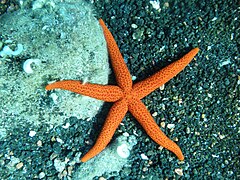
Starfish or sea stars are star-shaped echinoderms belonging to the class Asteroidea. Common usage frequently finds these names being also applied to ophiuroids, which are correctly referred to as brittle stars or basket stars. Starfish are also known as asteroids due to being in the class Asteroidea. About 1,900 species of starfish live on the seabed in all the world's oceans, from warm, tropical zones to frigid, polar regions. They are found from the intertidal zone down to abyssal depths, at 6,000 m (20,000 ft) below the surface.

The Asterinidae are a large family of sea stars in the order Valvatida.
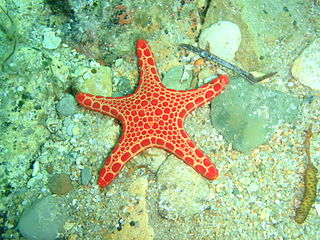
Goniasteridae constitute the largest family of sea stars, included in the order Valvatida. They are mostly deep-dwelling species, but the family also include several colorful shallow tropical species.

Henricia is a large genus of slender-armed sea stars belonging to the family Echinasteridae. It contains about fifty species.
Odontohenricia is a genus of starfish in the family Echinasteridae.
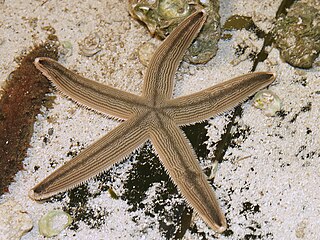
Luidia clathrata is a tropical species of starfish in the family Luidiidae. It is variously known as the slender-armed starfish, the gray sea star, or the lined sea star. It is found in the western Atlantic Ocean.
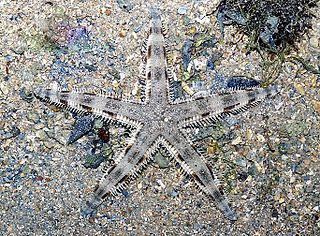
Archaster typicus is a species of starfish in the family Archasteridae. It is commonly known as the sand star or the sand sifting star but these names are also applied to starfish in the genus Astropecten. It is found in shallow waters in the Indo-Pacific region.

The orange knobby star, Echinaster echinophorus, is a species of sea star found in the Caribbean Sea and along the Atlantic coast of South America.
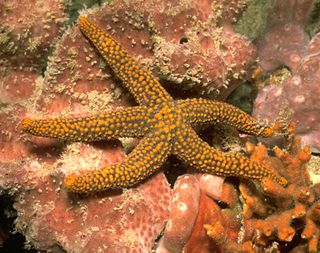
Echinaster spinulosus, the small spine sea star, is a species of sea star found in shallow parts of the western Atlantic Ocean, the Caribbean Sea and Gulf of Mexico.
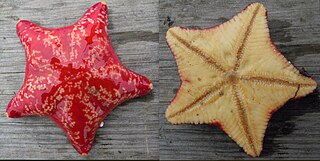
Poraniidae is a family of starfishes in the order Valvatida.

Metrodira subulata is a species of starfish in the family Echinasteridae. It is found on the seabed in shallow parts of the Indo-Pacific region.
Aleutihenricia is a genus of starfish in the family Echinasteridae in the order Spinulosida.
Henricia lisa is a species of starfish in the family Echinasteridae found in deep water in the northern Atlantic Ocean.
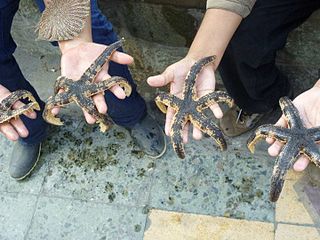
Luidia magellanica is a species of starfish in the family Luidiidae. It is found in the southeastern Pacific Ocean on the coast of South America.

Echinaster luzonicus, the Luzon sea star, is a species of starfish in the family Echinasteridae, found in shallow parts of the western Indo-Pacific region. It sometimes lives symbiotically with a copepod or a comb jelly, and is prone to shed its arms, which then regenerate into new individuals.
Henricia sexradiata is a species of starfish in the family Echinasteridae. It is native to the western Atlantic Ocean and the Gulf of Mexico.

Echinaster callosus, the warty sea star or the banded bubble star, is a species of starfish found in shallow parts of the western Indo-Pacific region. The disc and five slender arms are covered with white, pink, red or violet warts, often forming transverse bands of colour on the arms.
Henricia oculata, commonly known as the bloody Henry starfish, is a species of starfish in the family Echinasteridae. It is native to northwestern Europe. It was first described as Asterias oculata by the British zoologist Thomas Pennant in 1777, later being transferred to the genus Henricia.

Coscinasterias muricata is a species of starfish in the family Asteriidae. It is a large 11-armed starfish and occurs in shallow waters in the temperate western Indo-Pacific region.

Echinaster is a well-studied and common genus of starfish containing ~30 species and is the second-largest genus found within the family Echinasteridae. The genera Henricia and Echinaster encompass 90% of all the species found within the family Echinasteridae. It contains 30 species, however the number of species in this genus is still debatable because of uncertainty within the genera. This genus is currently sub-divided into two sub-genera: Echinaster and Othilia, evolutionary relationships between the sub-genera is not understood. Echinaster are found in the Pacific, Atlantic and Indian oceans, with most species being studied in the Gulf of Mexico and Brazil. The sub-genera Othilia is thought to encompass species mainly found in the Gulf of Mexico and Brazil. Echinaster is often one of the most studied species within the family Echinasteridae and is often used to find evolutionary relationships.

